What makes a school?
In a time of rapid social and economic change, well-resourced schools are more important than ever. People for Education’s 2019 annual report on schools (available in English and French) raises concerns about the potential impact of the province’s plans to “modernize” education, while at the same time reducing funding for the teachers and other supports that play key roles in schools.
The report, based on survey responses from 1254 schools across Ontario, talks about the school as an ecosystem. In order for that ecosystem to thrive, schools need a combination of: 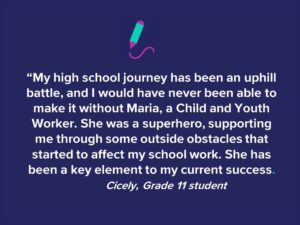
- People—from educators, psychologists, educational assistants, and social workers, to administrative staff and custodians.
- Resources—things like access to technology, library space, and professional learning time.
- Community connections—connections to supports and learning opportunities beyond the school.
All of these components work together to create a healthy educational ecosystem that supports all students in developing the competencies and skills they need for long-term success.
Tracking the impact of policy implementation
Effective policy implementation requires evidence, coherent strategy, and targeted resources. The data in this year’s report illustrate the positive impact when policy change is accompanied by resources and coherent strategies. For example, after years of funding increases and clear policy direction, our data show that the proportion of schools with Indigenous education programs has doubled.
However, the report also finds that the province’s imprecise fundraising policy has failed to address the impact of family income on schools’ capacity to raise money for things like technology, libraries, and classroom supplies.
Regional disparities for school libraries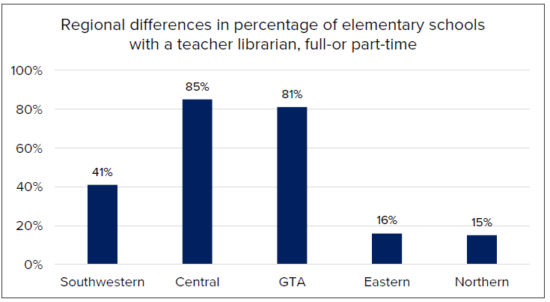
The traditional school library is evolving into a diversified – and essential – learning space, where teachers and students not only access books, but also engage with a wide range of technology and resources, and develop collaborative cross-curricular projects. However, findings in the report show that northern and rural elementary schools are much less likely to have staff in their libraries:
In 2019:
- The proportion of elementary schools with a teacher-librarian, full- or part-time has declined from 80% in 1998, to 54% in 2019.
- 9% of Ontario elementary schools have neither a teacher-librarian nor a library technician.
Special education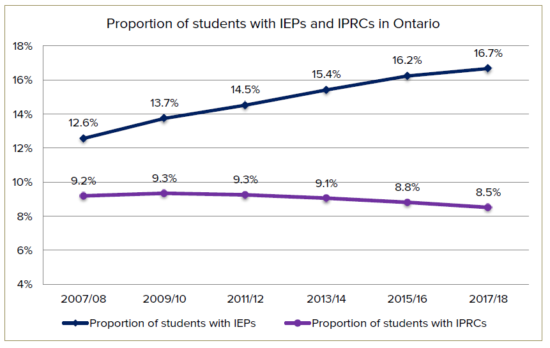
Despite years of adjustments to policy and funding for special education, principals continue to report special education as one of their greatest areas of strain. The proportion of students requiring/receiving special education support has increased steadily over the last two decades, however over one third of the funding for special education is based on demographic data from 2006.
In 2019:
- 60% of elementary and 53% of secondary schools report that there are restrictions on the number of students who can be assessed for special education each year. However the vast majority report that students waiting for an assessment are receiving some special education support.
- The average ratio per school of special education students to special education teachers is 38 to 1 in elementary and 77 to 1 in secondary schools.
Indigenous Education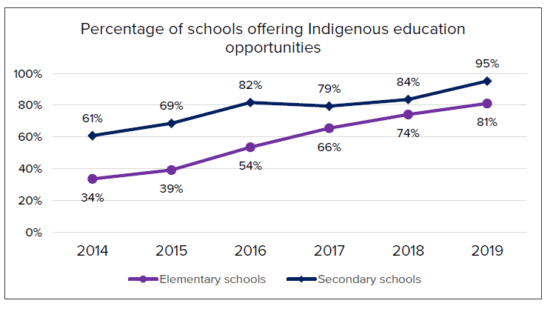
Since 2014, when we first began tracking Indigenous education opportunities in Ontario schools, the number of principals reporting these opportunities has increased dramatically.
In 2019:
- 81% of elementary and 95% of secondary schools report at least one Indigenous education opportunity, up from 34% and 59% respectively in 2014
- 68% of elementary and 80% of secondary schools offer professional development for staff around Indigenous cultural issues, up from 25% and 34% respectively in 2014.
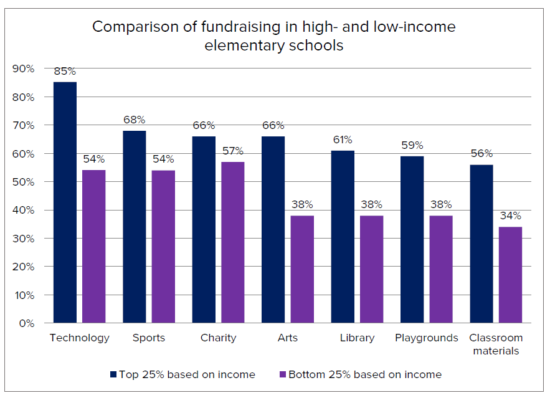 Fundraising and equity
Fundraising and equity
According to the report “Experiences outside of the classroom help students develop competencies and skills that are foundational for success in today’s economy and complex world. When schools rely on fundraising to provide these opportunities, it can create inequities. If public education in Ontario is to provide every child with an equitable chance for success, all students must have access to the programs, resources, and activities that foster competencies for long-term success.”
In 2019:
- School boards’ audited financial statements show that Ontario schools raised a total of over $583 million through school-generated funds.
- 26% of elementary schools report raising $20,000 or more, up from 7% in 2001, and 16% in 2015.
- In elementary schools, the top 10% of fundraising schools raised 33 times the amount raised by the bottom 10%, with some schools raising as much as $100,000.
- In secondary schools, the top 5% of schools raised as much as the bottom 82% combined, with some schools reporting raising $220,000.
e-Learning and career and life planning
The report also includes excerpts from two reports released earlier this year:
- Connecting to success, which looks at technology use in classrooms, including Bring Your Own Device (BYOD) policies and e-learning courses for high school students.
- Roadmaps and Roadblocks, which focuses on career and life planning, guidance, and streaming in Ontario’s schools.
Monitoring the impact of policy and funding change
Over the next few years, as education policy and funding changes are implemented across Ontario, the Annual Ontario School Survey will be an important source of data to monitor their impact.
